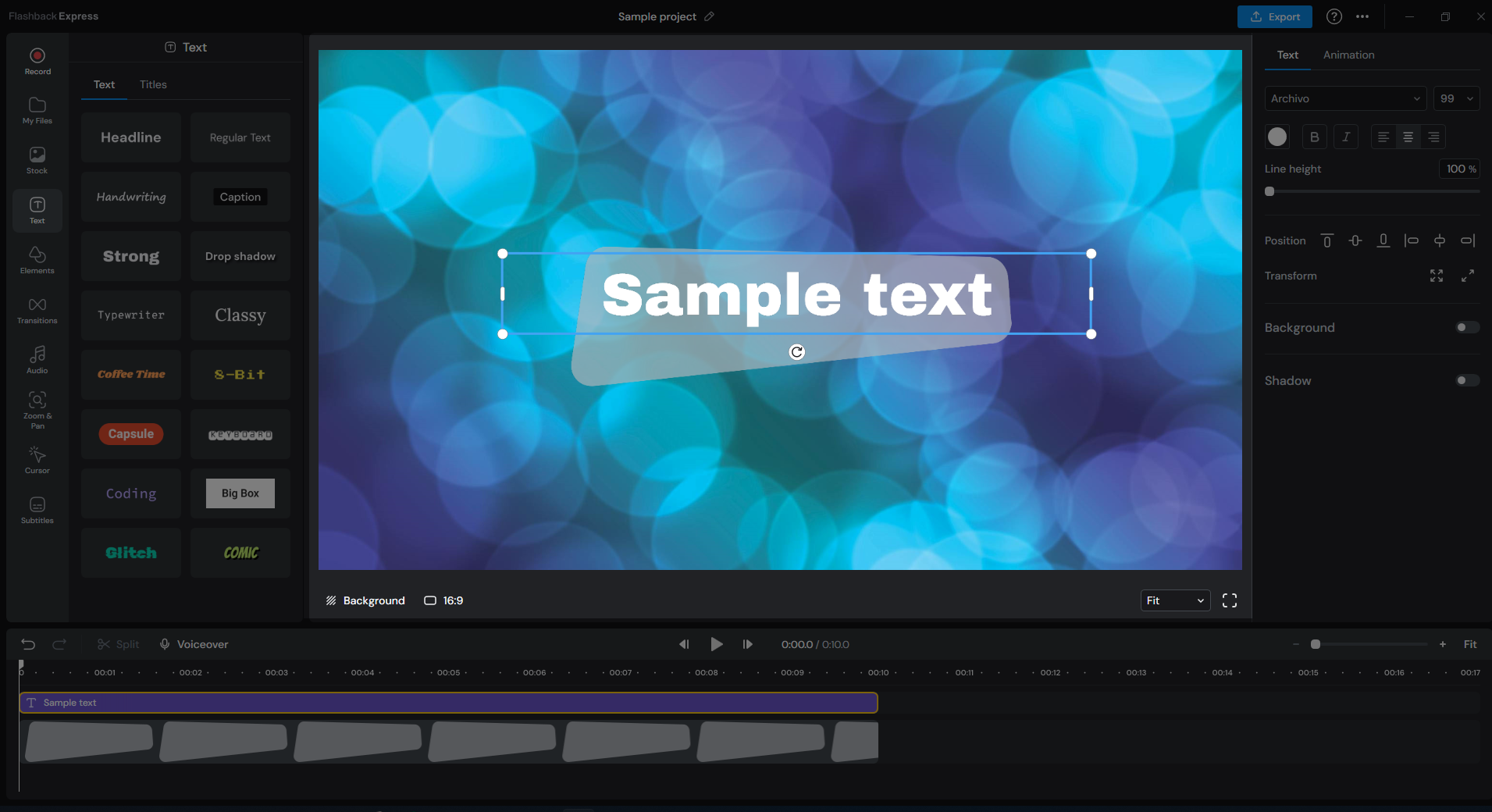Flashback Express 7
User Manual
Downloading and Installing
Recording a Video
Recorder Window
Recorder Settings
Selecting What To Record
Recording the Mouse Cursor
Starting and Stopping Recording
Recorder Control Bar
Advanced Recording Options
Annotating While Recording
Recording on a computer with dual GPUs
Previewing a Recording
Editing a Project
Editing Basics
Navigating the Project Editor
Working with Media
The Timeline
The Video Canvas
Styling Media
Editing Preferences
Exploring Media
Videos
Images
Animations
Shapes
Backgrounds
Text
Titles
Audio
Voiceovers
Subtitles
Blurs
Flashback Pro Movies
Applying Effects
Exporting
Licensing Flashback Express 7
Free vs Licensed Use
Purchasing a Flashback Express 7 License
Registering a Flashback Express 7 license
Upgrading From Pro 5 or Express 6
Managing Your Subscriptions
Feature Credits
Registering on an offline PC
Deploying a license to multiple PCs
License Troubleshooting
Misc.
How To Guides
Make a clip from a recording
Replace a voiceover
Record a facecam video
Schedule a recording session
Highlight the mouse cursor
Edit audio for an imported video
How To Move a Project to a New Computer
Record a clear voiceover
Flashback Express 7 Quick Start Guide
Flashback Express 7 FAQs
Flashback Express 6
User Manual
Downloading and Installing
Getting Setup to Record
The Recorder Window
Recording the Screen
Recording Windows and Regions
Recording Sound
Recording a Webcam
Recording the mouse cursor
Recording Settings
Recording
The Recorder Control Bar
Starting, Pausing and Stopping a Recording
Discarding or Restarting a Recording
Saving your recording
Scheduling a recording
Auto-trimming
Editing and Uploading
The Video Window
The Edit & Upload Window
Making a Clip
Uploading a Video
Exporting to other formats
Exporting Audio
Adding Subtitles
Licensing
Flashback Express Free vs Licenced
Purchasing a Flashback Express 6 license
Registering a Flashback Express 6 license
Registering Flashback Express 6 on an offline PC
Deploying a Flashback Express 6 license to multiple PCs
Flashback Express License 6 Troubleshooting
Feature Credits for Transcrptions
Misc.
How To Guides
How to record a facecam video
How to make a clip
How to schedule a recording session
How to capture the mouse cursor
Flashback Express 6 Quick Start Guide
Flashback Express 6 FAQs
Camigo
User Manual
Getting Started
Camigo System Requirements
Downloading and installing
Setting up Camigo
Checking for Updates
Camigo Settings
Using Camigo
Customizing your video
Licensing
Support
Camigo Quick Start Guide
Camigo FAQs
Video Converter
User Manual
Getting Setup
Video Converter System Requirements
Downloading and installing Video Converter
Preferences
Free Trial
Using Video Converter
Converting Format
Format settings
Turbo Conversion
Creating Clips
Cropping a video
Applying Effects
Adding Watermarks
Changing Speed
Inserting Subtitles
Licensing Video Converter
Video Converter Quick Start Guide
Video Converter FAQs
Table of Contents
- All Categories
- Flashback Express 7
- User Manual
- Editing a Project
- Editing Basics
- The Video Canvas
The Video Canvas
Updated
by Gareth Casey
The Video Canvas occupies the center of the Project Editor and shows you the image of the project that you are working on.

Naming the Project
The name of a project will displayed with the thumbnail on the Hub and will be used as the default filename when exporting your project when you have finished editing it.
Each new project will be given a default name of 'Untitled Project' followed by the date and time that it was created. This name is displayed above the video preview.
You can edit the name by clicking the  button that appears above the video preview and changing it the default name to your new name.
button that appears above the video preview and changing it the default name to your new name.
Setting the Project Ratio
Depending on what you intend to use your video for, you may need to select a specific aspect ratio for the project. For example, if you want to upload to certain social media platforms, they may require a square aspect ratio instead of a rectangle aspect ration. Or they might require a portrait aspect ratio instead of landscape.
The current ratio that is being used is displayed below the bottom left corner of the Canvas. Clicking on  will allow you to choose from a number of preset ratios or create your own custom ratio.
will allow you to choose from a number of preset ratios or create your own custom ratio.
Note - This just sets the ratio, not the resolution. The resolution will be selected when exporting.
Setting the Project Background
By default, the Video Canvas will simply be black and you can then add whatever you want on top of it. However, you can changethe background to a different color or even an image.
Click Background below the bottom left corner of the Canvas to change the background.
You can then change colour by choosing from a number of preset colors on the Background panel that appears or create your own custom color by clicking More... at the bottom of the Background panel.
Or can set the image to be a background by switching to the Image tab of the Background panel to choose from one of the stock backgrounds or import your own image by clicking Import... at the bottom of the Background panel.
Adding Media
Media, such as videos, images, etc, can be added by simply dragging them from the Media Panel and dropping it on the Video Canvas. The media will then appear on the Video Canvas in the exact spot that it was dropped and will appear on top of all existing media objects that have already been added to the Video Canvas.
Repositioning Media
Any media object can be moved around the Video Canvas by simply clicking and dragging it to a new position on the canvas.
Objects can also be sent backward or brought forwards relative to other objects by right clicking on it ans selecting from 'Bring forward', 'Bring to front', 'Send Backwards' and 'Send to back'. Doing this will also automatically change which track the object appears in on the Timeline.
Resizing Media
Any media object can be resized by clicking and dragging the corners of the object. When resizing in this way, the proportions of the object will be locked so it will always increase in height and width together.
For Videos and Images, clicking and dragging on the edges of the object will allow you to crop the image down to just show part of the image. For all other types of media, dragging the edge will simply change the size of the object in that single direction rather than changing the hieght and width together.
Playback Size
When working on a project you may find that you need to zoom in or out to help you position objects better. Or you might want to switch to a fullscreen view to get a better idea of how the final thing might look when exported and played back in a video player.
You can adjust the zoom of the video playback by clicking on the zoom dropdown menu below the bottom right corner of the video preview and choosing one of the zoom levels. By default, the zoom level will be set to Fit, which will make the preview appear as large as possible without cutting off any of the image.
You can switch to fullscreen playback by clicking the  button below the bottom right corner of the video preview.
button below the bottom right corner of the video preview.
